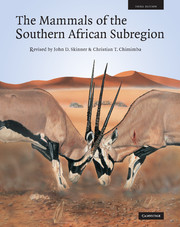Book contents
- Frontmatter
- Contents
- Editorial board
- Acknowledgements
- Foreword
- Preface
- The Mammal Research Institute
- R. H. N. Smithers
- Explanatory notes
- SUPERCOHORT AFROTHERIA
- Order AFROSORICIDA
- Order MACROSCELIDEA
- Order TUBULIDENTATA
- COHORT PAENUNGULATA
- SUPERCOHORT EUARCHONTAGLIRES COHORT GLIRES
- COHORT EUARCHONTA
- SUPERCOHORT LAURASIATHERIA
- COHORT FERUNGULATA
- Bibliography
- Appendix 1 Conservation status of southern African mammals
- Appendix 2 Colloquial names
- Index of scientific names
- Index of English colloquial names
- List of subscribers
- Plate Section
- Plate Section
- Plate Section
- Plate Section
- Plate Section
- Plate Section
- Plate Section
Order AFROSORICIDA
from SUPERCOHORT AFROTHERIA
Published online by Cambridge University Press: 05 July 2013
- Frontmatter
- Contents
- Editorial board
- Acknowledgements
- Foreword
- Preface
- The Mammal Research Institute
- R. H. N. Smithers
- Explanatory notes
- SUPERCOHORT AFROTHERIA
- Order AFROSORICIDA
- Order MACROSCELIDEA
- Order TUBULIDENTATA
- COHORT PAENUNGULATA
- SUPERCOHORT EUARCHONTAGLIRES COHORT GLIRES
- COHORT EUARCHONTA
- SUPERCOHORT LAURASIATHERIA
- COHORT FERUNGULATA
- Bibliography
- Appendix 1 Conservation status of southern African mammals
- Appendix 2 Colloquial names
- Index of scientific names
- Index of English colloquial names
- List of subscribers
- Plate Section
- Plate Section
- Plate Section
- Plate Section
- Plate Section
- Plate Section
- Plate Section
Summary
BASED ON A comprehensive mitochondrial and nuclear gene dataset, Stanhope et al. (1998a, 1998b) assigned golden moles and tenrecs to a new order named Afrosoricida, within the supra-ordinal clade Afrotheria. The name ‘Afrosoricida’ is unsuitable since it contains no soricids and could lead to confusion with the shrew subgenus Afrosorex Hutterer 1986. Application of Simpson's (1945) principle of reasonable emendation for taxa above the family level also identifies the name ‘Tenrecomorpha’, first proposed by Butler (1972: 113) for a grouping of golden moles and tenrecs, as a prior and more explicit name for this clade. The proposal that this order should be called Tenrecoidea (Malia et al., 2002) is also flawed since Simpson first coined this name in 1931 for a superfamilial grouping. Given that Afrosoricida has become entrenched in recent literature, it was reluctantly adopted by Bronner et al. (2003).
The existence of the Afrosoricida clade, and its affinities with other Afrotherian taxa, is strongly supported by large concatenated sets of DNA sequences (Madsen et al., 2001; Murphy et al., 2001a, 2001b), protein sequence signatures (Van Dijk et al., 2001) and extensive amino acid sequences from both the mitochondrial and nuclear genomes (Waddell et al., 2001). These affinities, however, conflict with traditional phylogenies based on morphological and palaeontological data, which suggest instead a closer relationship of tenrecs and chrysochlorids to core insectivores (Order Eulipotyphla).
- Type
- Chapter
- Information
- The Mammals of the Southern African Sub-region , pp. 1 - 21Publisher: Cambridge University PressPrint publication year: 2005
- 8
- Cited by



